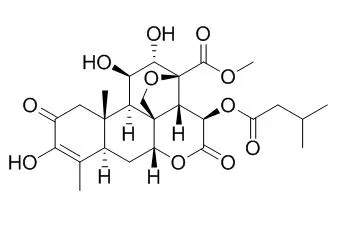| Description: |
Bruceine A has antibabesial activity, it can inhibit the in vitro growth of Babesia gibsoni in canine erythrocytes at lower concentration and kill the parasites within 24 hr at a concentration of 25 nM; it show strong antitrypanosomal activities with IC(50) values in the range of 2.9-17.8nM. Bruceine A has anthelmintic activity, it exhibits significant activity against Dactylogyrus intermedius with EC(50) values of 0.49 mg/L. Bruceine A exhibits NF-κB p65 inhibition, and cytotoxic potential against HT-29, HeLa, and HL-60 cells . |
| In vitro: |
| Vet Parasitol. 2008 Dec 20;158(4):288-94. | | In vitro antitrypanosomal activities of quassinoid compounds from the fruits of a medicinal plant, Brucea javanica.[Pubmed: 18986767 ] | The medicinal plant Brucea javanica (L.) Merr. (Simaroubaceae) is widely distributed throughout Asia where its bitter fruits have been used in traditional medicine for various ailments.
METHODS AND RESULTS:
Fifteen C-20 quassinoids were isolated from the fruits of B. javanica and examined for their in vitro antitrypanosomal activities against trypomastigotes of Trypanosoma evansi. Bruceine A, bruceantinol, bruceine C, brusatol, and bruceine B showed strong antitrypanosomal activities with IC(50) values in the range of 2.9-17.8nM, which compared well with the standard trypanocidal drugs diminazene aceturate (IC(50)=8.8nM) and suramin (IC(50)=43.2nM). However, dehydroBruceine A, dehydrobruceine B, and dehydrobrusatol were about 2100, 900, and 1200 times less active, respectively, than Bruceine A, bruceine B, and brusatol.
CONCLUSIONS:
The relationship of the structure and antitrypanosomal activity of these quassinoid compounds suggested that the presence of a diosphenol moiety in ring A and the nature of the C-15 side chain are important for their activities against T. evansi. This is the first report on the antitrypanosomal activity of isolated quassinoids.of the C-15 side chain are important for their activities against T. evansi. This is the first report on the antitrypanosomal activity of isolated quassinoids. | | Vet Parasitol. 2011 Apr 19;177(1-2):127-33. | | In vivo anthelmintic activity of bruceine A and bruceine D from Brucea javanica against Dactylogyrus intermedius (Monogenea) in goldfish (Carassius auratus).[Pubmed: 21196080 ] | The present study was designated to ascertain the anthelmintic activity of the dried fruits of Brucea javanica and to isolate and characterise the active constituents.
METHODS AND RESULTS:
The methanol extract from the fruits of B. javanica showed significant anthelmintic activity against Dactylogyrus intermedius (EC(50) (median effective concentration) value=49.96 mg l(-1)). Based on this finding, the methanol extract was fractionated on silica gel column chromatography in a bioassay-guided fractionation affording two known quassinoids showing potent activity, Bruceine A and bruceine D. Both Bruceine A and D exhibited significant activity against D. intermedius with EC(50) values of 0.49 mg l(-1) and 0.57 mg l(-1), respectively, which were more effective than the positive control, mebendazole (EC(50) value=1.25 mg l(-1)). In addition, the 48-h median lethal concentration (LC(50)) for Bruceine A and D against the host (Carassius auratus) was 10.6-fold and 9.7-fold higher than the EC(50) for D. intermedius.
CONCLUSIONS:
These results provide evidence that the isolated compounds might be potential sources of new anti-parasitic drugs for the control of Dactylogyrus. This is the first report on an in vivo anthelmintic investigation for B. javanica against D. intermedius. | | J Vet Med Sci. 2009 Jan;71(1):33-41. | | Evaluation of efficacy of bruceine A, a natural quassinoid compound extracted from a medicinal plant, Brucea javanica, for canine babesiosis.[Pubmed: 19194074] | Bruceine A, a natural quassinoid compound extracted from the dried fruits of Brucea javanica (L.) Merr., was evaluated for its antibabesial activity in vitro and in vivo.
METHODS AND RESULTS:
Bruceine A inhibited the in vitro growth of Babesia gibsoni in canine erythrocytes at lower concentration compared with the standard antibabesial drug diminazene aceturate and killed the parasites within 24 hr at a concentration of 25 nM. Oral administration of Bruceine A at a dosage of 6.4 mg/kg/day for 5 days resulted in no clinical findings in a dog with normal ranges of hematological and biochemical values in the blood. Three dogs were infected with B. gibsoni and two of them were treated with Bruceine A at a dosage of 6.4 mg/kg/day for 6 days from day 5 post-infection. An untreated dog developed typical acute babesiosis symptoms including severe anemia, high fever, and complete loss of appetite and movement. However, the two Bruceine A-treated dogs maintained their healthy conditions throughout the experimental period of 4 weeks although complete elimination of parasites from the peripheral blood was not achieved and decreases in the packed cell volume and the erythrocyte and platelet counts were observed.
CONCLUSIONS:
Since natural quassinoid compounds have been used as traditional medicines for the treatment of various ailments including cancer and malaria, the present results suggest that Bruceine A or other related compounds are potential candidates for the treatment of canine babesiosis. | | Bioorg Med Chem. 2009 Mar 15;17(6):2219-24. | | Bioactivity-guided isolation of cytotoxic constituents of Brucea javanica collected in Vietnam.[Pubmed: 19026551] |
METHODS AND RESULTS:
Five new triterpenoids (1-5), together with two known quassinoids, bruceantin (6) and Bruceine A (7), and a known flavonolignan, (-)-hydnocarpin (8), were isolated from the chloroform-soluble subfraction of a methanol extract of the combined twigs, leaves, and inflorescence of Brucea javanica collected in Vietnam. The structures of the new compounds 1-5 were established on the basis of spectroscopic methods. All isolates were evaluated for cytotoxicity against a small panel of human cancer cell lines.
CONCLUSIONS:
Quassinoids 6 and 7 were found to be highly active against these cell lines. (-)-Hydnocarpin (8) showed a potentiating effect when combined with both 6 and 7, during cytotoxicity testing using the MCF-7 human breast cancer cell line. |
|






 Cell. 2018 Jan 11;172(1-2):249-261.e12. doi: 10.1016/j.cell.2017.12.019.IF=36.216(2019)
Cell. 2018 Jan 11;172(1-2):249-261.e12. doi: 10.1016/j.cell.2017.12.019.IF=36.216(2019) Cell Metab. 2020 Mar 3;31(3):534-548.e5. doi: 10.1016/j.cmet.2020.01.002.IF=22.415(2019)
Cell Metab. 2020 Mar 3;31(3):534-548.e5. doi: 10.1016/j.cmet.2020.01.002.IF=22.415(2019) Mol Cell. 2017 Nov 16;68(4):673-685.e6. doi: 10.1016/j.molcel.2017.10.022.IF=14.548(2019)
Mol Cell. 2017 Nov 16;68(4):673-685.e6. doi: 10.1016/j.molcel.2017.10.022.IF=14.548(2019)